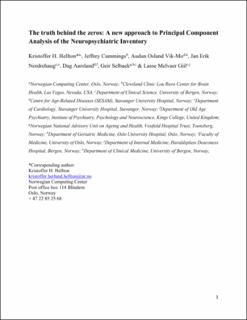| dc.contributor.author | Hellton, Kristoffer Herland | |
| dc.contributor.author | Cummings, Jeffrey | |
| dc.contributor.author | Vik-Mo, Audun Osland | |
| dc.contributor.author | Nordrehaug, Jan Erik | |
| dc.contributor.author | Aarsland, Dag | |
| dc.contributor.author | Selbæk, Geir | |
| dc.contributor.author | Melvær, Giil Lasse | |
| dc.date.accessioned | 2021-06-28T07:34:31Z | |
| dc.date.available | 2021-06-28T07:34:31Z | |
| dc.date.created | 2020-04-30T09:10:49Z | |
| dc.date.issued | 2021 | |
| dc.identifier.issn | 0027-3171 | |
| dc.identifier.uri | https://hdl.handle.net/11250/2761490 | |
| dc.description.abstract | Psychiatric syndromes in dementia are often derived from the Neuropsychiatric Inventory (NPI) using principal component analysis (PCA). The validity of this statistical approach can be questioned, since the excessive proportion of zeros and skewness of NPI items may distort the estimated relations between the items. We propose a novel version of PCA, ZIBP-PCA, where a zero-inflated bivariate Poisson (ZIBP) distribution models the pairwise covariance between the NPI items. We compared the performance of the method to classical PCA under zero-inflation using simulations, and in two dementia-cohorts (N = 830, N = 1349). Simulations showed that component loadings from PCA were biased due to zero-inflation, while the loadings of ZIBP-PCA remained unaffected. ZIBP-PCA obtained a simpler component structure of “psychosis,” “mood” and “agitation” in both dementia-cohorts, compared to PCA. The principal components from ZIBP-PCA had component loadings as follows: First, the component interpreted as “psychosis” was loaded by the items delusions and hallucinations. Second, the “mood” component was loaded by depression and anxiety. Finally, the “agitation” component was loaded by irritability and aggression. In conclusion, PCA is not equipped to handle zero-inflation. Using the NPI, PCA fails to identify components with a valid interpretation, while ZIBP-PCA estimates simple and interpretable components to characterize the psychopathology of dementia. | en_US |
| dc.language.iso | eng | en_US |
| dc.publisher | Routledge | en_US |
| dc.rights | Attribution-NonCommercial-NoDerivatives 4.0 Internasjonal | * |
| dc.rights.uri | http://creativecommons.org/licenses/by-nc-nd/4.0/deed.no | * |
| dc.title | The Truth behind the Zeros: A New Approach to Principal Component Analysis of the Neuropsychiatric Inventory | en_US |
| dc.type | Journal article | en_US |
| dc.type | Peer reviewed | en_US |
| dc.description.version | acceptedVersion | en_US |
| dc.rights.holder | Copyright 2020 Taylor & Francis Group, LLC | en_US |
| cristin.ispublished | true | |
| cristin.fulltext | postprint | |
| cristin.qualitycode | 1 | |
| dc.identifier.doi | 10.1080/00273171.2020.1736976 | |
| dc.identifier.cristin | 1808757 | |
| dc.source.journal | Multivariate Behavioral Research | en_US |
| dc.source.pagenumber | 70-85 | en_US |
| dc.identifier.citation | Multivariate Behavioral Research. 2021, 56 (1), 70-85. | en_US |
| dc.source.volume | 56 | en_US |
| dc.source.issue | 1 | en_US |

